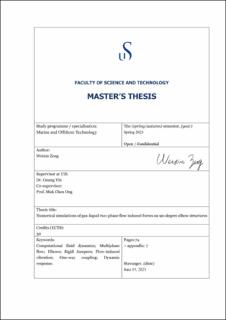| dc.description.abstract | 90-degree elbow structures such as pipelines with bends and rigid jumpers, are commonly used for flow transportation in subsea systems. The produced flow from the subsea wells is normally a multiphase flow which is a mixture of oil, water, gas polymer, and even rocks. The gas-liquid two-phase flow is a typical kind of multiphase flow conveyed in subsea systems, which has several flow regimes depending on different gas and liquid velocities. The transportation of gas-liquid two-phase flow in subsea pipeline systems can be a challenge because slug flow will occur with a specific combination of the gas and liquid velocities. For a slug flow, the gas phase coalesces into large-scale bubbles named Taylor bubbles and accumulates at the elbow sections,
which will lead to large pressure fluctuation at these sections. With the peak of flow-induced forces acting on these sections, the pipelines will begin vibrating which may lead to even fatigue damage to the structures. In this thesis, the gas-liquid two-phase flow-induced forces on 90-degree elbow structures are numerically investigated by a one-way coupling method based on computational fluid dynamics (CFD) simulation
and finite element analysis. The Reynolds numbers in the present simulations are in the range of 2.4×105 ~ 3.2×105. The mesh convergence studies are performed to determine the optimal computational grid resolution. Subsequently, the validation studies are conducted, and compared with published experimental results. Then, the numerical simulations in the open-source CFD package OpenFOAM and open-source finite-element program CodeAster are carried out to study the gas-liquid two-phase flow in pipeline structures. The studied pipeline structures in the present study cover pipe with one or two 90-degree elbows, uniplanar jumper, and multiplanar jumper. It is concluded that the flow-induced forces mainly peak at the sections where the slugging phenomena happen or the Taylor bubbles are frequently formed. For the pipe with one or two
elbows, increasing the number of fixed supports can effectively reduce the reaction forces fluctuation of fixed supports. Moreover, the maximum deformation occurs at the top of the jumpers, with an evident sinking of the middle component, where the material tensile capacity should be considered in the design of subsea jumpers. Additionally, specific descriptions of the multiphase flow field are provided including volume fraction contour, iso-surface plot, and secondary flow. | |
